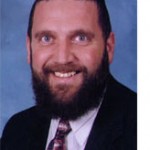By Rabbi Baruch Lederman

SAN DIEGO — Yaakov and Yosef, after years of separation, were finally reunited. Yaakov thought his beloved son had been killed. Yosef, though a viceroy in Egypt, was still essentially a prisoner. He believed he would never be able leave Egypt to see his father again. How great was their joy when they were finally reunited. Losing, or almost losing something makes us appreciate it even more as the following true story written by Dr. Kenneth M.Prager illustrates:
When I was an elementary school student in yeshiva, my classmates and I used to find amusing a sign that was posted just outside the bathroom. It was an ancient Jewish blessing, commonly referred to as the asher yatzar benediction, that was supposed to be recited after one relieved oneself. For grade school children, there could be nothing more strange or ridiculous. Blessings were reserved for prayers, for holy days, or for thanking G-d for food, but surely not for a bodily function that evoked smirks and giggles.
It took me several decades to realize the wisdom that lay behind this blessing that was composed by Abayei, a fourth-century Babylonian rabbi. Abayei’s blessing is contained in the Talmud (Brachot 60b), an encyclopedic work of Jewish law. The Jewish religion is chock-full of these blessings, or brachot, as they are called in Hebrew. In fact, an entire tractate of Talmud, 128 pages in length, is devoted to brachot.
An observant Jew is supposed to recite this blessing in Hebrew after each visit to the bathroom. We young yeshiva students were reminded of our obligation to recite this prayer by the signs that contained its text that were posted just outside the restroom doors.
It was not until my second year of medical school that I first began to understand the appropriateness of this short prayer. Pathophysiology brought home to me the terrible
consequences of even minor aberrations in the structure and function of the human body. At the very least, I began to no longer take for granted the normalcy of my trips to the bathroom. Instead, I started to realize how many things had to operate just right for these minor interruptions of my daily routine to run smoothly.
I thought of Abayei and his blessing. Seeing patients whose lives revolved around their dialysis machines and others with colostomies and urinary catheters, I realized how wise the rabbi had been.
There was one unforgettable patient whose story reinforced the truth and beauty of the asher yatzar for me forever. Josh was a 20-year-old student who sustained an unstable fracture of his third and fourth cervical vertebrae in a motor vehicle crash. He nearly died from his injury and required emergency intubation and ventilatory support. He was initially totally quadriplegic but for weak flexion of his right biceps.
A long and difficult period of stabilization and rehabilitation followed. There were promising signs of neurological recovery over the first few months that came suddenly and unexpectedly: movement of a finger here, flexion of a toe there, return of sensation here, adduction of a muscle group there. With incredible courage, hard work, and an excellent physical therapist, Josh improved day by day. In time, and after what seemed like a miracle, he was able to walk slowly with a leg brace and a cane.
But Josh continued to require intermittent catheterization. The urologists were very pessimistic about his chances for not requiring catheterization. They had not seen this occur after a spinal cord injury of this severity.
Then the impossible happened. I was there the day Josh no longer required a urinary catheter. I thought of Abayei’s asher yatzar prayer. Pointing out that I could not imagine a
more meaningful scenario for its recitation, I suggested to Josh, who was also a yeshiva graduate, that he say the prayer. He agreed. As he recited the ancient bracha, tears welled in my eyes. Josh is my son.
*
Rabbi Lederman is spiritual leader of Congregation Kehillas Torah in San Diego